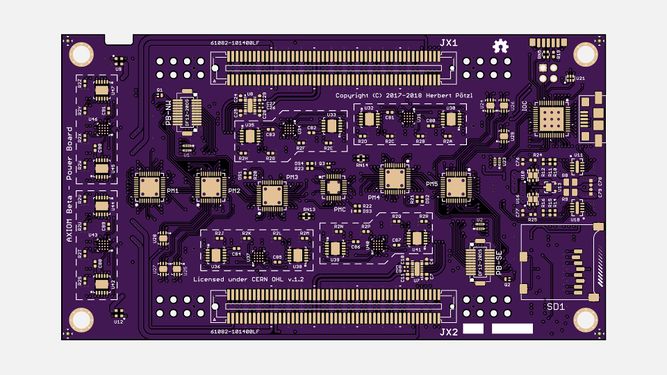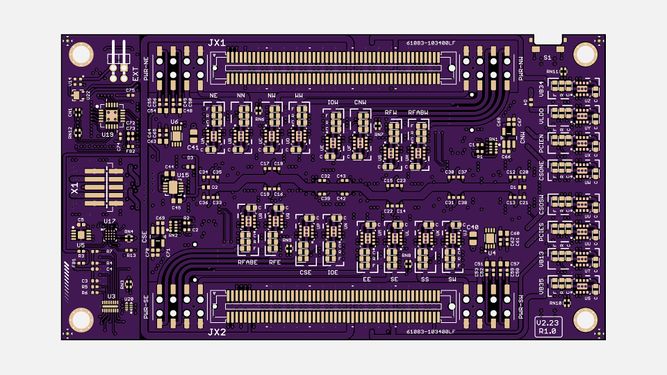Difference between revisions of "Beta Power Board"
| Line 57: | Line 57: | ||
Revision as of 18:54, 27 March 2020
1 About
The Beta Power Board sits between the Beta Main Board and the MicroZed™ in the cameras PCB stack. It generates all the different supply voltages for the chips and logic on the other PCB’s inside the camera. It also monitors currents so that it can estimate remaining power based on the recorded consumption. Version 1 of the Beta Power Board has the 8 different voltage rails calibrated at factory. In case of a future hardware upgrade that require any power rail to have a different reference voltage this calibration needs to be redone.
2 Features
2.1 V0.30
- Nine high current (1.5A) low dropout (LDO) linear regulators for IO
- Voltages on MicroZed, Center Solder-on-Area (CSO), Mainboard Routing
- Fabrics (RF), Plugins and Shields.
- Eight high current adjustable LDOs for Interface Board (2) and Sensor
- Frontend (6) Power Rails.
- Ten low current regulators for Mainboard Bus Power (I2C, SPI, JTAG) and CSO Supply.
- Extensive instrumentation to monitor (Voltage and Current) and control all Power Rails.
- USB (FT232 based) Debug Interface (JTAG).
- 512 Byte EEPROM for Identification and Configuration Information.
- Temperature Monitoring.
3 Planned Features for V1
- Dual 3A step-down converter for increased input range (6-17V).
- Always-on low-power controller (MCU) for the two main power supply rails with input voltage monitoring, power button and fan interface.
- Nine high current (1.5A) low dropout (LDO) linear regulators for IO voltages on MicroZed, Center Solder-on-Area (CSO), Main Board routing fabrics (RF), Plugin modules and Shields.
- Eight high-current-adjustable LDOs for Interface Board (2) and sensor front-end (6) power pails.
- Ten low-current regulators for Main Board bus power (I2C, SPI, JTAG) and CSO supply.
- Extensive instrumentation to monitor power (voltage and current) and control all power rails.
- Voltage level conversion for primary and secondary system management bus.
- Unique ID and 128 Byte user-flash for configuration information.
- Secondary SD card Interface.
- Dual temperature monitoring.
4 Planned Changes for V2
- DC barrel connector attached directly to the PB with a cable
- mechanical trimmer (discontinued) replacement -> switching regulators with digital voltage control
- PICO SPOX power input connector will be moved "into" the PB so the cable can be routed inside the camera enclosure towards the backside
- RGB LED and pushbutton (ALPS SKSNLAE010 currently considered) moved from smart power adapter to PB (top side, north east)
- Connector for extension PCB (RGB LED, buttons, FAN control) and legacy FAN control (moved from Main Board)
5 Revisions
Current: AXIOM Beta Power Board v0.30
Archive:
axiom beta power board v0.22 test
axiom beta power board v0.17 test
axiom beta power board v0.11 test
axiom beta power board v0.8 test
axiom beta power board v0.9 test
6 Calibrating Voltages
This describes the process required when factory assembling the power board hardware in the AXIOM Beta stack.
./power_init.sh
./power_on.sh
wait a bit
./pac1720_info.sh
This will output something like:
ZED_5V 4.8828 V [1f40] +10.1562 mV [104] +677.08 mA BETA_5V 4.8828 V [1f40] +1.2891 mV [021] +85.94 mA HDN 3.2812 V [1500] +0.0000 mV [000] +0.00 mA PCIE_N_V 3.2422 V [14c0] +0.0000 mV [000] +0.00 mA HDS 3.2031 V [1480] +0.0000 mV [000] +0.00 mA PCIE_S_V 3.2422 V [14c0] +0.0000 mV [000] +0.00 mA RFW_V 3.2422 V [14c0] -0.0391 mV [fff] -2.60 mA IOW_V 3.2617 V [14e0] +0.0000 mV [000] +0.00 mA RFE_V 3.2422 V [14c0] +0.0000 mV [000] +0.00 mA IOE_V 3.2812 V [1500] +0.0000 mV [000] +0.00 mA VCCO_35 2.4219 V [ f80] -0.0391 mV [fff] -2.60 mA VCCO_13 2.4609 V [ fc0] +0.0000 mV [000] +0.00 mA PCIE_IO 2.4609 V [ fc0] -0.0781 mV [ffe] -5.21 mA VCCO_34 2.4609 V [ fc0] +0.9766 mV [019] +65.10 mA W_VW 2.7734 V [11c0] +0.0000 mV [000] +0.00 mA N_VW 2.8125 V [1200] +0.0000 mV [000] +0.00 mA N_VN 2.7734 V [11c0] -0.0391 mV [fff] -2.60 mA N_VE 2.8516 V [1240] +0.0000 mV [000] +0.00 mA E_VE 2.6953 V [1140] -0.0391 mV [fff] -2.60 mA S_VE 2.8516 V [1240] +0.0000 mV [000] +0.00 mA S_VS 2.7344 V [1180] -0.0391 mV [fff] -2.60 mA S_VW 2.8516 V [1240] -0.0781 mV [ffe] -5.21 mA
now run:
watch -n 0.2 ./pac1720_info.sh
which will display the voltages in a clear screen and constantly update the values until you press CTRL+C
The PCB labels and the labels in the CLI correspond like the following:
WW = W_VW NW = N_VW NN = N_VN NE = N_VE SW = S_VW SS = S_VS SE = S_VE EE = E_VE
Use a tiny screwdriver and adjust the trimmers on the PCB until your values look like this:
W_VW 2.4609 V [ fc0] -0.0391 mV [fff] -2.60 mA N_VW 3.2422 V [14c0] +0.0000 mV [000] +0.00 mA N_VN 1.8750 V [ c00] -0.0391 mV [fff] -2.60 mA N_VE 3.2617 V [14e0] +0.0000 mV [000] +0.00 mA E_VE 3.2812 V [1500] +0.0391 mV [001] +2.60 mA S_VE 1.9922 V [ cc0] +0.0000 mV [000] +0.00 mA S_VS 2.9883 V [1320] -0.0391 mV [fff] -2.60 mA S_VW 1.9531 V [ c80] -0.1172 mV [ffd] -7.81 mA



